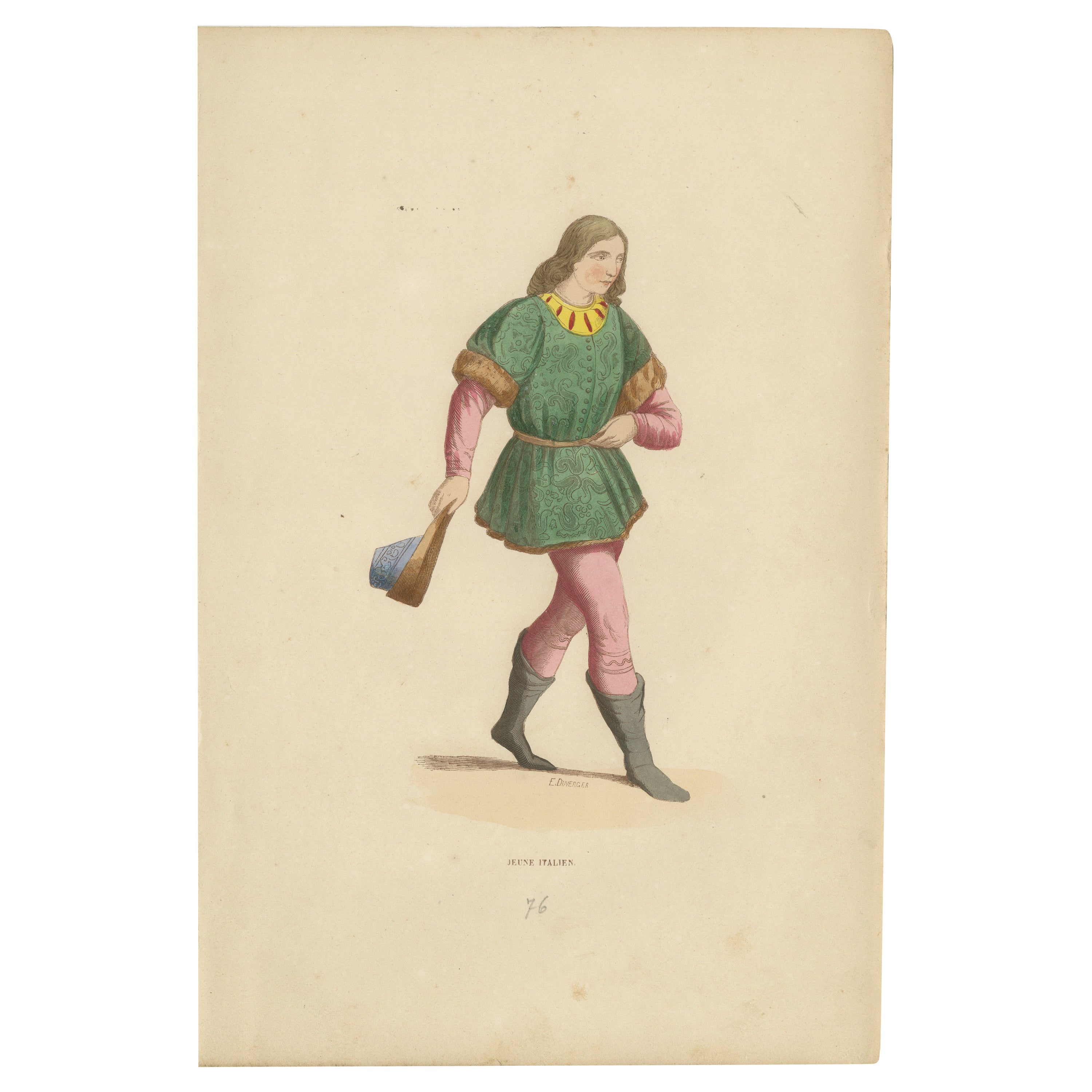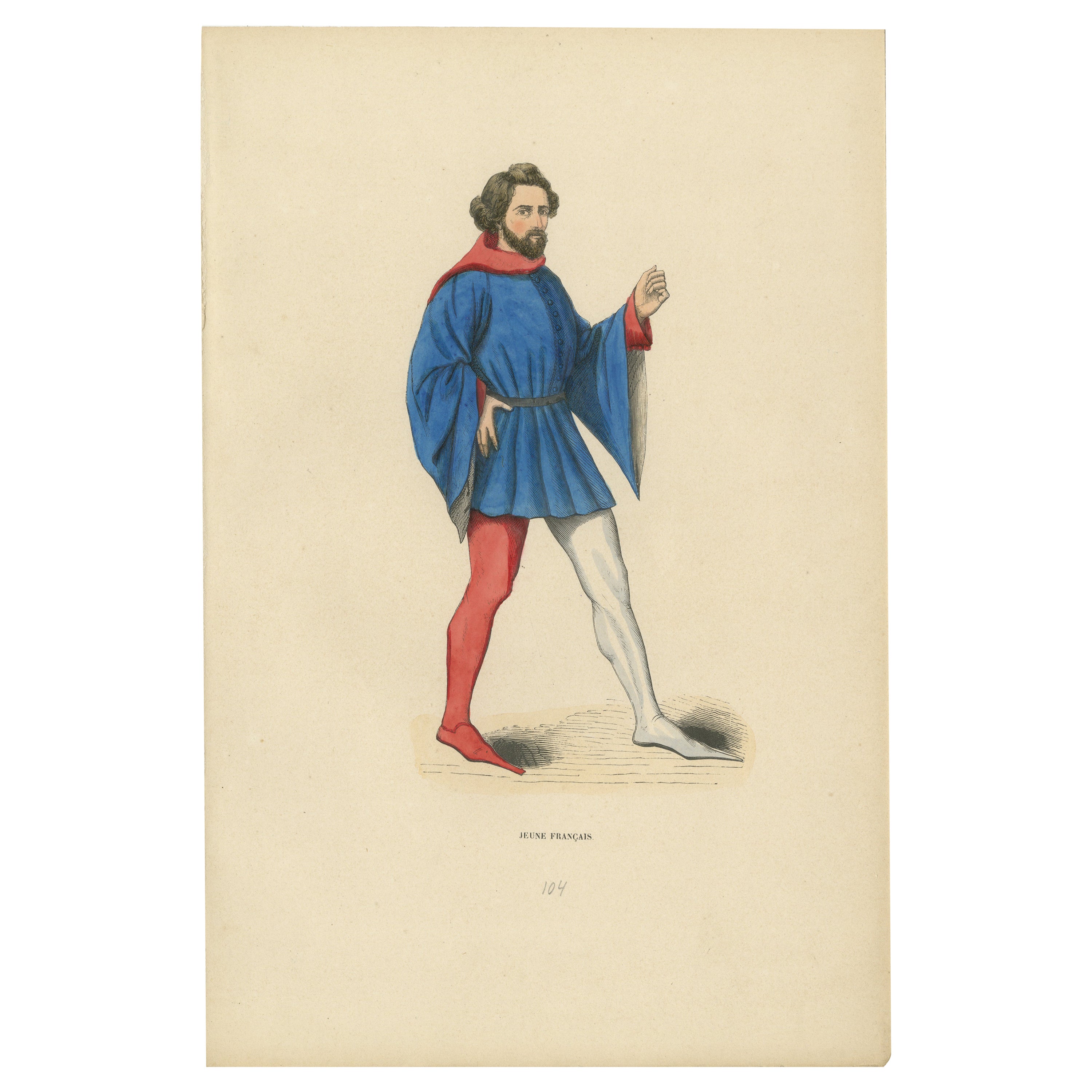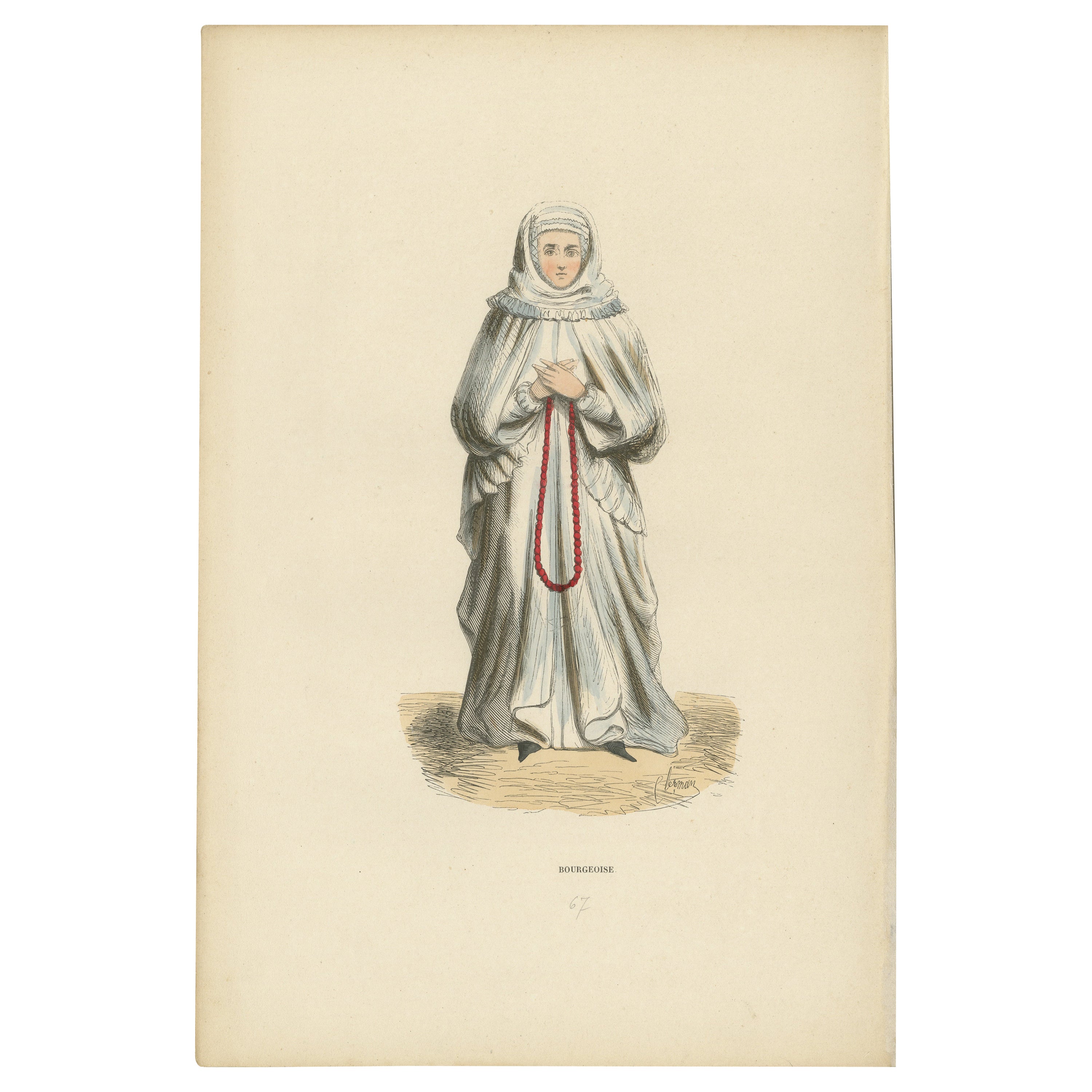Items Similar to Medieval Matrimony: A Union in the Gothic Halls, Hand-Colored in 1847
Want more images or videos?
Request additional images or videos from the seller
1 of 7
Medieval Matrimony: A Union in the Gothic Halls, Hand-Colored in 1847
About the Item
This print from "Costume Di Moyen Age" (Costumes of the Middle Ages) published in Paris in 1847, depicts a scene from the medieval era. The image features a group of individuals in an indoor setting, likely a part of a noble class, given the richness of their attire and the elegant interior.
A central figure in a blue cape with a red lining is in a dialogue or exchange with a person wearing a green and yellow patterned garment. They both are in the foreground and appear to be the primary subjects of this interaction. Behind them, there are other individuals who seem to be part of the scene, including a person in red robes who is possibly a clergyman, given the context and attire, which resembles ecclesiastical clothing.
The background is adorned with Gothic architectural elements such as pointed arches and intricate detailing. Statues or figures are set within the architectural framework, suggesting a church or a similarly important building. The use of bright, primary colors is notable, and the attention to the detail in the clothing suggests a significant event, possibly a ceremony like a marriage, as indicated by the word "Casamiento" (meaning marriage in Spanish) at the bottom of the print.
Overall, the print is rich in historical clothing detail, showcasing the elaborate textiles and fashions of the Middle Ages in Western Europe, specifically the intricate designs and the layering of clothing which was indicative of one's social status during that time.
The colors have a nice glow over them. Historically, egg whites, known as glair, and sometimes egg yolk were indeed used in illumination and painting, particularly in manuscripts, to give colors a brighter appearance and to add a sheen or gloss to the work. This technique was quite common during the Middle Ages and into the Renaissance.
Egg whites can be applied as a varnish over pigments to enhance their brightness and to protect the colors. This application could make the colors appear more vivid and also add a slight glossy sheen to the surface of the image.
Egg yolk, on the other hand, was commonly used as a binding agent in paint. It forms the basis of tempera paint, a medium that was widely used before the advent of oil painting. Egg yolk helps to create a durable and long-lasting color that adheres well to various surfaces.
In the context of the print from 1847, it's less likely that egg whites or yolks were used directly on the print, as by that time, commercial printing processes would have been more advanced and less reliant on such manual methods. However, if this print is a representation of an earlier style or is meant to mimic the appearance of hand-painted manuscripts, the original artists might have employed techniques or materials that gave a similar effect to those achieved with egg-based binders and varnishes.
- Dimensions:Height: 10.63 in (27 cm)Width: 7.09 in (18 cm)Depth: 0 in (0.02 mm)
- Materials and Techniques:
- Period:
- Date of Manufacture:1847
- Condition:Good. Overal very light toning and light soiling but the image itself clean and hand-colored almost 200 years ago and still in expliciet colors. Aged paper with typically warm, yellowish-brown hue, mostly around the edges. Study the image carefully.
- Seller Location:Langweer, NL
- Reference Number:
About the Seller
5.0
Platinum Seller
These expertly vetted sellers are 1stDibs' most experienced sellers and are rated highest by our customers.
Established in 2009
1stDibs seller since 2017
1,947 sales on 1stDibs
Typical response time: <1 hour
- ShippingRetrieving quote...Ships From: Langweer, Netherlands
- Return PolicyA return for this item may be initiated within 14 days of delivery.
More From This SellerView All
- Renaissance Youth: The Italian Page in a Hand-Colored Engraving, 1847Located in Langweer, NLTitle: "Renaissance Youth: The Italian Page" Description: This print depicts a young Italian page, a common figure in Renaissance courts, whose duties often included serving nobilit...Category
Antique 1840s Prints
MaterialsPaper
- Scholar of the Codex: A Medieval Jurist in Study, 1847Located in Langweer, NLThe image depicts a person labeled "Docteur des Lois," which translates to "Doctor of Laws." This term historically refers to an individual who has achieved advanced scholarly status in the field of law, equivalent to the modern term "Juris Doctor." The figure is seated at a lectern, deeply engrossed in a large book, which likely represents legal texts or scholarly works. The individual is attired in a robe with a fur-lined cape, suggesting a status of academic or professional distinction. The robe is red, a color often associated with higher education and learning. The headwear appears to be a type of turban, which was a common academic regalia in certain cultures and times. The setting and attire suggest that this person is a scholar or a high-ranking legal professional, possibly a university professor or a magistrate from the medieval or Renaissance period. Egg whites can be applied as a varnish over pigments to enhance their brightness and to protect the colors. This application could make the colors appear more vivid and also add a slight glossy sheen to the surface of the image. Egg yolk, on the other hand, was commonly used as a binding agent in paint. It forms the basis of tempera paint, a medium that was widely used before the advent of oil painting. Egg yolk helps to create a durable and long-lasting color that adheres well to various surfaces. In the context of the print from 1847, it's less likely that egg whites or yolks were used directly on the print, as by that time, commercial printing processes would have been more advanced and less reliant on such manual methods. However, if this print is a representation of an earlier style or is meant to mimic the appearance of hand-painted...Category
Antique 1840s Prints
MaterialsPaper
- Scholar of the Arts: The Medieval Academic, 1847Located in Langweer, NLTitle: "Scholar of the Arts: The Medieval Academic" Description: This print illustrates a learned individual, likely a doctor of the arts or a scholar, from the medieval period. The...Category
Antique 1840s Prints
MaterialsPaper
- The Church's Defender: Advocate in Arms on a Hand-Colored Lithograph, 1847Located in Langweer, NLAn original hand-colored lithograph showing the "Avocat des Eglises," which translates to "Advocate of the Churches." This title likely refers to a legal position within the church,...Category
Antique 1840s Prints
MaterialsPaper
- Devout Reflection: A Medieval Bourgeoise in Prayer, 1847Located in Langweer, NLTitle: "Devout Reflection: A Medieval Bourgeoise in Prayer" Description: This print presents a serene image of a woman, labeled as a bourgeoise, engaged in an act of devotion. Her a...Category
Antique 1840s Prints
MaterialsPaper
- French Youth in Traditional Medieval Attire, 1847Located in Langweer, NLTitle: "French Youth in Traditional Medieval Attire" Description: This hand-colored engraving, titled "Jeune Français," which translates to "Young Frenchman," is part of the histori...Category
Antique 1840s Prints
MaterialsPaper
You May Also Like
- Hans Burgkmair After Maximillian Pageant Medieval Antique Hand Colored WoodcutLocated in Keego Harbor, MIA historic medieval antique hand colored woodcut titled “Maximillian Pageant” by Hans Burgkmair. Posthumous print, circa 1580. Hans Burgkmair crea...Category
Antique 16th Century Prints
MaterialsPaper
- Vintage Poster Historical Construction Gothic Dome Medieval City Historical SiteLocated in Berghuelen, DEThe double sided poster shows the construction of a Gothic dome and on the backside the view inside a medival city. Colorful print on paper. Measur...Category
Mid-20th Century German Country Prints
MaterialsPaper
- Antique Duck Hunter in the Field Hand Colored Landscape Engraving 20"Located in Dayton, OHAntique hand colored duck hunt engraving featuring a man with his gun in the field. Dimensions: 19.5" x 0.75" x 16.5" / Sans Frame - 11.5" x 8" (Width x Depth x Height)Category
Early 20th Century Prints
MaterialsPaper
- Hand-Colored Engraving of the Ceiling of the Church of Santa Costanza in FrameLocated in Pembroke, MAA large, nicely-framed Italian hand-colored engraving in tones of terracotta and black (17th century, with more recent matte and frame) by Pietro Bartoli. The engraving depicts the mosaic ceiling in the church of Santa Costanza outside of Rome, which was studied by the ecclesiatical archaeologist Giovanni Ciampini. The mosaic ceiling no longer exists, but is known through various depictions of the artwork, such as this engraving. The images include Christian imagery including the sacrifice of Cain and Abel and possibly Noah building the ark. The upper row of mosaics is believed to represent scenes from the New Testament, with caryatids dividing the ceiling into twelve segments. The engraving is captioned in Latin: "Opus Musiuum olim in tholo Templi, quod vulgo creditur Bacchi, nunc Sancte Constantie extra Portam Piam cariatides, et Telamones in duodecium dividant Segmenta, ubi plura autumnales ferias, et piscationis Genium demostrant, iuxta interpretionem Ciampini qui mediatatem exhibet Veterum monum." In the 17th century, the church of Santa Costanza was known as the "Temple of Bacchus," and was the site of rowdy Bacchic festivals until Pope Clement XI banned the rites in 1720. Pietro Santo...Category
Antique 17th Century Italian Baroque Prints
MaterialsPaper, Paint, Wood, Ink
- 1860s Feu de Joie Winner of Oakes Hand Colored Engraving Harry Hall Racing HorseLocated in Dayton, OHFramed mid 19th century hand colored engraving depicting "Feu-de-joie, Winner of the Oaks" by Harry Hall, 1862. Framed in a dark stained wood frame with beaded inner trim and Egg and...Category
Antique 1860s Prints
MaterialsPaper
- J S Prout, the Upper Goulburn, Victoria', Hand Colored Engraving, U K, 1874By John Skinner Prout, N.W.S. 1Located in Chatham, ONJohn Skinner Prout (1805-1876) - 'the upper Goulburn, Victoria' - antique steel plate engraving after a painting by J. S. Prout - from 'Australia' by Edwin Carton Booth - hand colore...Category
Antique Late 19th Century British Victorian Prints
MaterialsPaint, Paper





